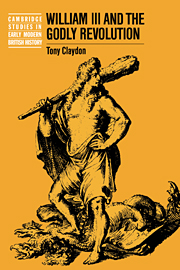Book contents
- Frontmatter
- Contents
- List of illustrations
- Acknowledgements
- List of abbreviations
- Notes on style
- Introduction
- 1 Courtly reformation and the revolution of 1688–1689
- 2 The resources for royal propaganda
- 3 The propagation of courtly reformation
- 4 Courtly reformation, the war, and the English nation
- 5 Courtly reformation and the politics of party
- 6 Courtly reformation and country politics
- Conclusion
- Bibliography
- Index
- Cambridge Studies in Early Modern British History
3 - The propagation of courtly reformation
Published online by Cambridge University Press: 09 October 2009
- Frontmatter
- Contents
- List of illustrations
- Acknowledgements
- List of abbreviations
- Notes on style
- Introduction
- 1 Courtly reformation and the revolution of 1688–1689
- 2 The resources for royal propaganda
- 3 The propagation of courtly reformation
- 4 Courtly reformation, the war, and the English nation
- 5 Courtly reformation and the politics of party
- 6 Courtly reformation and country politics
- Conclusion
- Bibliography
- Index
- Cambridge Studies in Early Modern British History
Summary
COURTLY REFORMATION STRATEGIES
Having identified the human and material resources available to William, it is time to investigate how these resources were actually used. Broadly, the government's propagandists attempted to legitimate the regime by proving that it was reforming many different areas of national life. They justified William's claim to be an instrument of God through a number of publicity campaigns designed to show his reformation acting in a variety of spheres. These campaigns were to some extent interdependent, and it is thus somewhat crude to separate them out. For the sake of clarity, however, six main strategies can be identified. First, William's publicists attempted to prove that the new monarchs had cleared the court of sin, and that they had made the royal household an appropriately virtuous engine of reform. Second, the king's men promoted a series of fasts and thanksgivings. These, they hoped, would cast their master in an Old Testament role and portray him turning his people back towards God. Third, a mantle of royal patronage was thrown over a number of initiatives to reform the nation's manners through the use of statute law. Fourth, William's pro-Dutch foreign policy was presented as a promotion of true godliness. Fifth, the king was shown improving the moral guidance and pastoral resources of the English church. Finally, William was depicted as an honest and frugal executive, purging waste and corruption from the machinery of his government.
- Type
- Chapter
- Information
- William III and the Godly Revolution , pp. 90 - 121Publisher: Cambridge University PressPrint publication year: 1996



